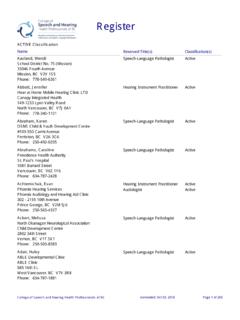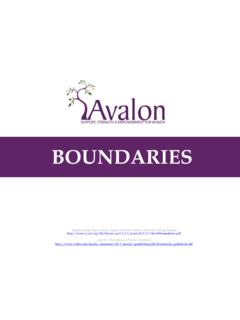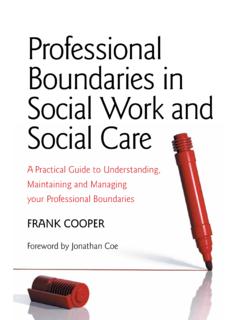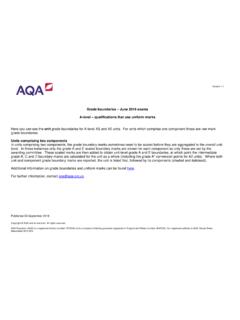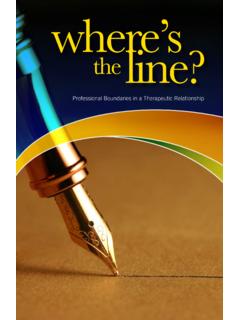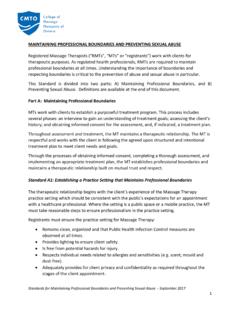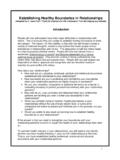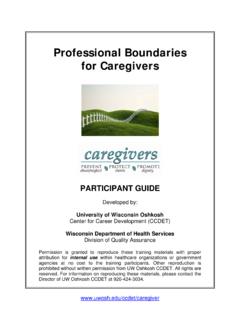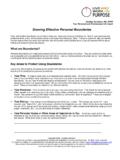Transcription of references - cshhpbc.org
1 references 1. British Columbia Rehabilitation Society. boundaries Workshop Materials. 1992. 2. College of Chiropractors of Ontario, College of Massage Therapists of Ontario, College of Physical Therapists of Ontario. Where's my line? Toronto, Ontario. Professional boundaries in a therapeutic relationship 3. College of Physical Therapists of Alberta. therapeutic relationships: Establishing and maintaining professional boundaries . [Online]. 2007 [cited 2008 Nov 18]; Available from: 4. College of Physical Therapists of BC.
2 Bylaw 55 (Code of Ethics). Vancouver, British Columbia, 2002. 5. College of Physiotherapists of Ontario. Guide to the standard for establishing and maintaining therapeutic relationships. [Online]. 2005 [cited 2008 Nov 18]; Available from: URL: 6. College of Registered Nurses of British Columbia. Practice support. Nurse-client relationships. [Online]. 2006 [cited 2008 Nov 18]; Available from: 7. College of Registered Nurses of Nova Scotia. Professional boundaries and expectations for nurse-client relationships.
3 Halifax, NS, 2002. 8. Schachter , Stalker , Teram E., Lasiuk , Danilkewich A. Handbook on sensitive practice for health care practitioners: Lessons from adult survivors of childhood sexual abuse. [Online]. 2008 [cited 2009 May 28];. Available from: URL: Copyright 2011 College of Speech or Hearing Professionals of British Columbia | All Rights Reserved relationships Personal versus Professional Relationships . What's the Difference? You've been treating a client on and off for several years and have gotten to know each other quite well.
4 Your relationship is at the point that it feels more like you are reconnecting with an old friend. This is a good thing right? College of Speech and Hearing Health Professionals of BC. September 2011. Or is it? The College of Speech and Hearing In order to answer this question you need to know how Health Professionals of BC gratefully a personal relationship and a professional relationship acknowledges permission from the differ from each other. Without knowing the differences College of Physical Therapists of between the boundaries of a personal and professional BC to adapt their publication on professional boundaries .
5 relationship , how will you know if the line between the two is blurred or even crossed? 2 3. differences between Professional & Personal Relationships relationship PROFESSIONAL PERSONAL. CHARACTERISTICS relationship relationship . Money is paid to the speech Money or hearing professional for Shared client care Limited to the duration of Length May last a lifetime assessment or treatment Confined to the Location No boundaries treatment area Purpose To provide care to client To enjoy oneself Defined by the appointment Spontaneous and Structure length (and nature of care unstructured required).
6 The speech or hearing professional is empowered Power Balance by professional skill and is Shared privy to the client's private information The speech or hearing Responsibility for the professional establishes and Shared relationship maintains the professional relationship The speech or hearing professional offers training Preparation for the and commitment and the Equal relationship client places their trust in this Adapted from: British Columbia Rehabilitation Society, 5. understanding the therapeutic relationship Recognize that there is Power There is an inherent power imbalance, in favour an element of risk in of the speech or hearing professional, because having both a therapeutic the speech or hearing professional has a disproportionate amount of knowledge compared relationship and a personal to the client, and the client relies upon the speech or hearing professional for care.
7 relationship with a client simultaneously. Trust Take care to clarify Clients assume that roles with your client. the speech or hearing professional has the knowledge, skills, and abilities to provide quality care. therapeutic relationships place the client's needs first and foremost, and are at the core of professional practice. Respect Speech or hearing Components of a therapeutic relationship professionals have a that a speech or hearing professional must responsibility to respect a client regardless of consider when managing the boundaries race, religion, ethnic of the relationship are: power, trust, origin, age, gender, respect, and closeness.
8 It is extremely sexual orientation, social difficult to maintain a therapeutic or health relationship if any of these are violated. Personal Closeness The context of a therapeutic relationship can include: physical closeness, varying degrees of undress, and disclosure of sensitive personal or emotional information which can lead to a client feeling vulnerable. 6 7. Professional boundaries are intended to set limits and clearly define a safe, therapeutic connection between speech or hearing professionals and their Individual speech or hearing professionals must use clinical judgment to determine therapeutic boundaries .
9 This can be difficult given that boundaries differ from person to person, from one situation to the next, and tend to change over A boundary is a dynamic line which, if crossed, will constitute unprofessional behaviour and misuse of power. How Do You Define Professional boundaries ? Some behaviours are never acceptable in a therapeutic relationship . boundary blurring Boundary violation is a deliberate behaviour There are grey areas' around It can be difficult to put your finger on by a speech or hearing professional that is professional boundaries that require exactly why you feel uneasy when a recognizably inappropriate and in violation of the use of good judgment and careful certain client comes in for treatment.
10 The nature of a therapeutic consideration of the context ( when, Ask yourself if a boundary was crossed if ever, is it appropriate to hug a client?). either by you or your client? therapeutic relationships that lead to abuse, While each separate situation may sexual relations, or romantic encounters are appear harmless, when put together To sum up: never appropriate and are prohibited. they may form a pattern indicating that a boundary crossing may boundary boundary has been Verbal and non verbal behaviours that are begin with seemingly never appropriate include: sarcasm, retaliation, innocent comments or violations intimidation, teasing or taunting, swearing, cultural slurs, and inappropriate tones of voice that express impatience or disclosures and escalate from 8 9.
